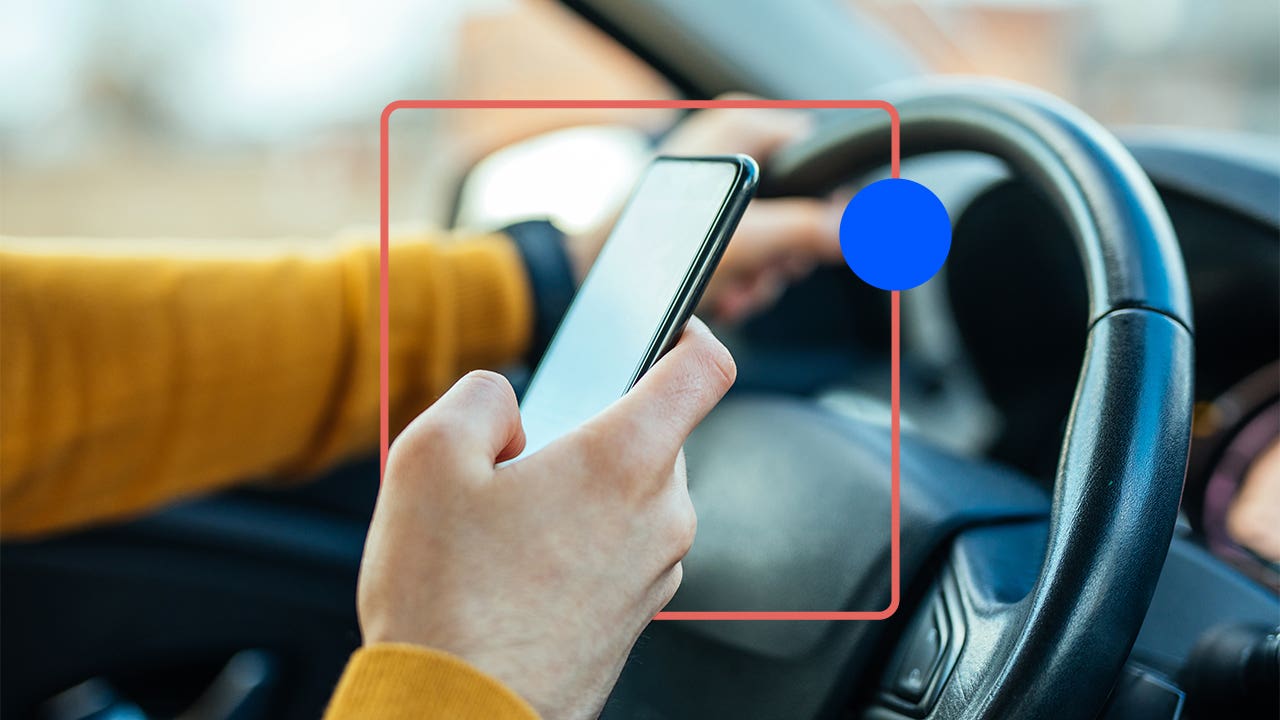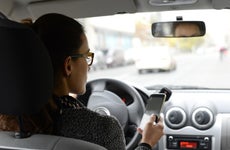Distracted driving: Why staying safe means staying focused

The Bankrate promise
At Bankrate, we strive to help you make smarter financial decisions. To help readers understand how insurance affects their finances, we have licensed insurance professionals on staff who have spent a combined 47 years in the auto, home and life insurance industries. While we adhere to strict , this post may contain references to products from our partners. Here's an explanation of . Our content is backed by Coverage.com, LLC, a licensed entity (NPN: 19966249). For more information, please see our .
Before you start up your car, it’s important to take a moment to put away your phone and center yourself. According to the National Highway Traffic Safety Administration, more than 3,000 people lost their lives in 2021 due to distracted driving. And it doesn’t stop there; the financial toll of distracted driving is substantial, from the cost of police citations, state fees, increased insurance rates and potential repair and medical expenses if an accident occurs — not to mention the devastating emotional distress it can cause. Understanding the impact of distracted driving and changing our driving behavior can help make roadways safer.
What is distracted driving?
Before we get into the dangers of distracted driving, we need to establish what distracted driving is. Put simply, distracted driving is any activity that impairs your ability to focus on the road. The NHTSA identifies three main categories of distracted driving:
- Visual: When drivers take their eyes off the road
- Manual: When drivers take their hands off the wheel
- Cognitive: When driver take their minds off the task of driving
Distracted driving may not always be obvious — even to the driver. Some examples of distractions include:
- Texting while driving
- Talking on the phone
- Playing music loudly
- Fidgeting with the car’s stereo/climate controls
- Talking to someone in the car
- Eating
- Putting on makeup
- Smoking
- Alcohol or drugs
- Sleep deprivation
What makes distracted driving so dangerous is how it impacts our ability to make safe driving decisions. For example, drivers focusing on their phones more than the road might not see someone stop abruptly, resulting in delayed reaction time and an accident. Or, a driver whose mind is otherwise preoccupied may not see an animal run into the road.
Moreover, juggling multiple things at one time does not give drivers clear situational awareness, meaning they could be making judgment calls based on incomplete information. This, coupled with delayed reaction times, can result in more accidents. Car accidents are not only physically dangerous, they can also wreak havoc on your finances. If you do not carry a full coverage car insurance policy, you might be stuck paying thousands out of pocket on your vehicle repairs. Additionally, your car insurance premium could skyrocket.
Not surprisingly, distracted driving is on the rise. Insurance expert Laura Adams points to the link between distracted driving and the increasing relationship people have with their smartphones. “We often think that teens are the only drivers who engage in dangerous behaviors behind the wheel,” Adams said, “But older drivers are just as susceptible.”
Distracted driving statistics
The NHTSA reports that in 2021, 3,522 people died and 362,415 people were injured as a result of distracted driving. The National Occupant Protection Use Survey (NOPUS) has tracked drivers’ electronic device usage in the U.S. since 2012. They observed three types of behavior regarding electronic devices:
- Drivers holding phones to their ears
- Drivers speaking with a visible headset on
- Driver visibly manipulating handheld devices
Of the drivers observed, female drivers tend to manipulate handheld devices more than men, and drivers between 16–24 use cell phones while driving the most. The following chart shows driver use of electronic devices by behavior and age in 2021.
| Age group | Drivers holding phones to their ears | Drivers with visible headsets | Drivers manipulating handheld devices |
|---|---|---|---|
| Age 16–24 | 3.7% | 0.2% | 5.4% |
| Age 25–69 | 2.5% | 0.4% | 3.4% |
| Age 70+ | 0.7% | 0.3% | 0.4% |
The Centers for Disease Control states when you look down to text or read a text for five seconds at 55 miles per hour, it is the same as driving across a football field without looking at the road. What makes this illustration even more troublesome is that in 2019, 39 percent of high school students admitted to sending an email or text while driving.
Not only does distracted driving have an impact on those driving, but it also affects pedestrians. Reports from the Insurance Institute of Highway Safety show 7,388 pedestrian fatalities in 2021, an 80 percent increase since 2009, when pedestrian deaths were at their lowest. “Pedestrian deaths, which typically occur at crosswalks and intersections, are also going up due to distracted drivers. It is a growing crisis with deadly consequences,” states Adams.
How distracted driving impacts insurance rates
The impact of distracted driving on your finances and car insurance rates can be costly. Most states issue traffic tickets when drivers are caught using a cell phone, but the law varies between states. For example, as of 2019 drivers in Alaska can receive a $500 fine and up to six points on their drivers license for using a handheld device within an active school zone or on school grounds. In New York, drivers can be fined up to $450 for using a cell phone or electronic device and receive points on their license. Accumulating more than 11 points within 18 months may result in a license suspension.
In states where cell phone violations are considered moving violations, drivers will likely see increased car insurance premiums due to a surcharge. In cases of license suspension, drivers need to wait until the state’s terms are fulfilled to reinstate their license and may need to switch to a non-standard insurance company if they need an SR-22 form filed on their behalf. Policyholders have to pay insurance companies to file an SR-22 and will most likely see any applicable surcharge added to their policy renewals.
How to prevent distracted driving
Adams recommends drivers “put their phones down to stay more focused on driving. This can help to reduce the number of distracted driving deaths.”
Tucking phones away and silencing all notifications is a great first step. Here are some more tips that can help you promote safe driving behavior:
- Use technology to your advantage: Most cell phones have free safe driving features that help prevent drivers from using their phones while driving. Apple has Driving Focus, which when activated, mutes incoming calls and texts and can send a customized auto response letting people know that you are driving. Android users may have similar solutions like Google Assist built into their phones or can download a free app.
- Be hands-free: Many vehicles allow drivers to pair their phones with the vehicle via Bluetooth to receive calls and send voice-activated messages. If you frequently use your phone for navigation, set your trip before starting your car and consider using a cell phone mount to keep the screen at eye level.
- Adjust your driving position before starting the car: Set up your music, modify the seating position, adjust your rear and side mirrors, and buckle up before you start your car.
- Use telematics to encourage safe driving: Several insurers offer telematics insurance programs, which not only provides a discount for safe driving, but can also be an excellent reminder to not touch your phone when driving. Most telematic apps register phone use when driving, which can reduce the discount you may receive.
- Limit distractions: Distracted driving isn’t just about your phone. Loud music, passengers, pets and children can distract drivers from staying focused on the road. Make sure your children are buckled up and have what they need before pulling out of the driveway. Fights and meltdowns from your tiniest passengers will happen. When they do, pull over and park in a safe location before turning around to address them.
- Get ready early or accept being late: As part of planning, you should eat and do your hair or makeup before leaving your home. This prevents you from trying to multitask driving and getting ready, which impairs your ability to focus solely on driving.
In all instances, try to plan ahead to eliminate your distractions when on the road. This may include taking frequent breaks on longer drives or preparing a playlist so you are not changing stations all the time.
Frequently asked questions
-
-
Using handheld phones for calls and texting may be illegal, depending on the laws in your state. Being under the influence, sleepy or distracted by conversation or music inside the car are also traffic offenses and could get you penalized if caught.
-
According to the NHTSA, there are three main kinds of distracted driving: visual, manual and cognitive. Visual distracted driving occurs when a driver takes their eyes off the road, and a manual distraction would be when a driver removes their hands from the steering wheel. For example, if someone is focused on changing the music on the radio instead of keeping their eyes up and hands on the wheel, that would be both a visual and manual distraction. A cognitive distraction is when a driver is not mentally focused on the road. For instance, if a driver is on their way to work and primarily thinking about their upcoming presentation instead of the road in front of them, they could be cognitively distracted.
-
If being distracted causes you to deviate from safe driving patterns, you can be pulled over and fined. If the distracted driving was the result of being under the influence, you may be charged with a DUI.
-
When distracted driving is serious enough to cause a traffic violation, your insurance rates will likely be affected. Traffic violations generally remain on your driving record for three to five years, depending on your state, after which your insurance costs may begin to lower. This may also depend on how far your insurer looks back into your record.
-
Most states have laws in place to encourage safe driving and penalize distracted driving. Some states ban handheld cell phone usage for all drivers, while others enforce rules for specific driving zones and inexperienced drivers. According to the Governors Highway Safety Association, 48 states ban texting while driving, 24 banned all handheld devices while driving and 37 states plus Washington, D.C., ban all cell phone use for inexperienced drivers. If you move or vacation in a different state, you may want to check with local law enforcement or the DMV to learn about the cell phone laws in your area.
-
Related Articles



